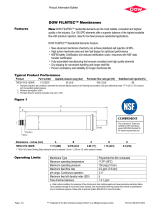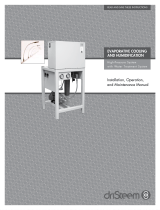
Design guide
Energy Recovery Device
iSave
Membrane cleaning of RO-system
hpp.danfoss.com

Design guide Membrane cleaning of the RO-system with iSave ERD
2
180R9214 / 521B1165 / DKCFN.PI.003.G6.02 / 09.2017
Table of Contents Membrane cleaning .................................................................................................................................................................3
Starting up the system ............................................................................................................................................................ 4
Starting up the system ............................................................................................................................................................ 5

Design guide Membrane cleaning of the RO-system with iSave ERD
3
180R9214 / 521B1165 / DKCFN.PI.003.G6.02 / 09.2017
Below procedures are general guidelines for
the membrane cleaning of SWRO-systems with
the Danfoss iSave. Procedure details may differ
depending on the system design.
The numbers marked in () refer to the
diagram’s below.
The purpose of membrane cleaning is to reduce
scaling and fouling in the membranes. For opti-
mal performance specific chemicals are required,
depending on the cause of the contamination.
After chemical treatment the system must be
flushed with fresh water. The flushing water,
coming out of the membranes, may consist of a
large amount of suspended inorganic particles. It
is important to assure that these particles are not
fed into the iSave(s) or pump(s).
NB! It is recommended to disconnect the
piping from the “HP in” of the iSave and flush
the contaminated water from the membranes
directly to drain. By disconnecting the pipes
there will be no accumulation of
contaminations in the HP-piping and
HP-valves. See P&ID no 2.
Membrane cleaning
The procedures below are based on Dow’s
Cleaning and Sanitization: Cleaning steps
described in Dow’s Form No. 609-02090-1005.
Other procedure may be used depending on the
membranes used.
Below procedure is according P&ID no 1.
1. Stop the high-pressure pump(s) (4), and stop
the iSave(s) (11).
2. Stop the seawater supply pump (A).
3. Close valve (9 and 27) and open valve (16 and
28), and feed cleaning solution through valve
(7).
4. Pump mixed cleaning solutions to the vessel
at conditions of low flow rate and low pressure
to displace the process water. Use only
enough pressure to compensate for the
pressure drop from feed to concentrate.
The pressure should be low enough that
essentially no or little permeate is produced.
A low pressure minimizes re-deposition of
dirt on the membrane. Dump the brine/
concentrate to prevent dilution of the
cleaning solution.
5. Recycle: After the process water is displaced,
cleaning solution will be present in the
concentrate/ brine stream. Recycle the
cleaning solution from the piping to the
cleaning solution tank.
6. Turn of the pump and allow the elements
to soak.

Design guide Membrane cleaning of the RO-system with iSave ERD
4
180R9214 / 521B1165 / DKCFN.PI.003.G6.02 / 09.2017
7. Feed the cleaning solution at high flow into
the “full flow cleaning” adapter (7). The high
flow rate flushes out the foulants removed
from the membrane surface by the cleaning.
8. Flush RO permeate or deionised water into
the “full flow cleaning” adapter (7).
Flush out the cleaning solution.
It is essential that the water used for the final
pre-flush is pre-filtered to a level described
in the datasheet.
9. Open valve (9) and continue flushing.
The iSave(s) may start to rotate backward –
this is OK.
10. When flushing is finalised – assure that no
foulants remain in the piping or valve (9).
11. Close the high pressure “full flow cleaning”
valve (7) and close valve (16 and 28).
12. Open valve (27)
Media filter
M
Permeate
iSave
F
F
F
Flowmeter
VFD
M
HP in
HP out
VFD
M
HP in
HP out
VFD
Fresh water
permeate flush
Full flow
cleaning/CIP
6
7
17
8
9
27
15
13
1011
11
12
19
Filter
3 micron
nominel
Filter
10 micron
absolut
Drain
4
18
5
M
4
18
VFD
LP in
20
F
*
*
Second stage filter: If recommended housing design and cartridges are not used, a second stage filter is required
1
21
2
PS
PI
PS
PI
PS
14
PI
PI
PI
PI
PI
3
A
B C
22
22
PS
24
23 23
25
25
26
26
16
CIP
28
Below procedure is according P&ID no 2.
1. Stop the high-pressure pump(s) (4), and stop
the iSave (11).
2. Stop the seawater supply pump (A).
3. Disconnect pipe in joint (9) and connect the
pipe to low pressure “Full flow cleaning”
joint (16).
4. Plug pipe in joint (9).
5. Close valve (27) and open valve (28)
6. Pump mixed cleaning solutions through valve
(7) to the vessel at conditions of low flow rate
and low pressure to displace the process
water. Use only enough pressure to
compensate for the pressure drop from feed
to concentrate.
The pressure should be low enough that
essentially no or little permeate is produced.
A low pressure minimizes re-deposition of dirt
on the membrane. Dump the brine/
concentrate to prevent dilution of the
cleaning solution.
7. Recycle: After the process water is displaced,
cleaning solution will be present in the
concentrate stream. Recycle the cleaning
solution from the piping to the cleaning
solution tank.
8. Turn of the pump and allow the elements to
soak.
9. Feed the cleaning solution at high flow into
the “full flow cleaning” adapter (7) on the
feed side of the membrane. The high flow rate
flushes out the foulants removed from the
membrane surface by the cleaning.
P&ID no. 1

Design guide Membrane cleaning of the RO-system with iSave ERD
5
180R9214 / 521B1165 / DKCFN.PI.003.G6.02 / 09.2017
P&ID no. 2
Media filter
M
Permeate
iSave
F
F
F
Flowmeter
v
VFD
M
HP in
HP out
VFD
M
HP in
HP out
VFD
Fresh water
permeate flush
Full flow
cleaning/CIP
6
7
17
8
15
13
1011
11
12
19
Filter
3 micron
nominel
Filter
10 micron
absolut
Drain
4
18
5
M
4
18
VFD
LP in
20
F
*
* Second stage filter: If recommended housing design and cartridges are not used, a second stage filter is required
1
21
2
PS
PI
PS
PI
PS
14
PI
PI
PI
PI
PI
3
A
B C
22
22
PS
24
23 23
25
25
26
26
9
27
CIP
28
16
Media filter
M
Permeate
iSave
F
F
F
Flowmeter
VFD
M
HP in
HP out
VFD
M
HP in
HP out
VFD
Fresh water
permeate flush
Full flow
cleaning/CIP
6
7
17
8
15
13
1011
11
12
19
Filter
3 micron
nominel
Filter
10 micron
absolut
Drain
4
18
5
M
4
18
VFD
LP in
20
F
*
*
Second stage filter: If recommended housing design and cartridges are not used, a second stage filter is required
1
21
2
PS
PI
PS
PI
PS
14
PI
PI
PI
PI
PI
3
A
B C
22
22
PS
24
23 23
25
25
26
26
9
27
CIP
28
16
10. Flush RO permeate or deionised water into
the “full flow cleaning” adapter (7) on the
feed side of the membrane. Flush out the
cleaning solution.
It is essential that the water used for the final
pre-flush is pre-filtered to a level described in
the datasheet.
11. When flushing is finalised – Close the high
pressure “full flow cleaning” valve (7) and
close valve (28).
12. Connect the high pressure pipe to joint (9)
again.

Danfoss A/S
High Pressure Pumps
Nordborgvej 81
SK-6430 Nordborg
Denmark
© Danfoss | DCS (im) | 2017.09
521B1165 | DKCFN.PI.00.G6.02 | 6
-
 1
1
-
 2
2
-
 3
3
-
 4
4
-
 5
5
-
 6
6
Ask a question and I''ll find the answer in the document
Finding information in a document is now easier with AI
Related papers
-
Danfoss 180F7021 User guide
-
Danfoss Start and stop of the SWRO User guide
-
Danfoss 180F7021 User guide
-
Danfoss 180F7021 User guide
-
Danfoss 180F7038 User guide
-
Danfoss iSave 40 Energy Recovery Device Owner's manual
-
Danfoss 180B7806 Installation guide
-
Danfoss 180F7021 User guide
-
Danfoss 180B3007 Installation guide
-
Danfoss 180F7003 User guide
Other documents
-
Aquatec DC 500 User manual
-
Protec PRO-8-1000-EP User manual
-
Unity Lab Services Barnstead Pacific TII User manual
-
 Filmtec FILMTEC-TW30-1812-100 User manual
Filmtec FILMTEC-TW30-1812-100 User manual
-
Condair 2593990-B 1901 HP-HPRO Installation guide
-
Condair 2591585-B 1901 MLPRO Installation guide
-
GE E4H-38K Operation and Maintenance Manual
-
GE E4LE-2200 User manual
-
GE Osmonics E4H Series User manual
-
 DriSteem 1000 Installation, Operation and Maintenance Manual
DriSteem 1000 Installation, Operation and Maintenance Manual







